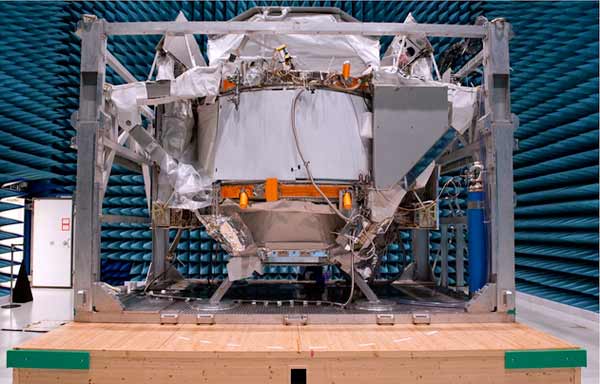Big Bang Detector Heads to Space

In an effort to uncover some of the universe’s greatest mysteries, an international team of researchers has developed the largest space-based particle physics detector. Known as the Alpha Magnetic Spectrometer (AMS-02), it will study the universe and its origins by searching for dark matter and antimatter and measuring the composition of cosmic rays with greater precision than any previous device.
“There is nothing else like it,” says Trent Martin, NASA’s project manager for the detector, which is being built by 56 institutions in 16 countries and sponsored by the U.S. Department of Energy. Head of the AMS-02 collaboration is 1976 Nobel Laureate Samuel Ting, also a professor of physics at MIT. The spectrometer is set to fly to the International Space Station on the final space shuttle mission, scheduled for February. It will be attached to the outside of the space station and gather roughly seven gigabytes of data per second. That data will be sent to a ground station for analysis.
The core of the spectrometer is its doughnut-shaped magnet, one meter in diameter. At its center are eight individual detectors. The magnet pulls particles in, bending them in a direction that corresponds to their charge. The new instruments in the center can then measure different aspects of the particles such as their trajectory, mass, velocity, speed, and energy. AMS-02 also has an “anticounter” that rejects particles that enter at the wrong angle; a star tracker and GPS for accurate position and orientation; and more than 650 microprocessors to transform the signals from the detectors into digital information for ground-based computers to analyze.
The only current space-based experiment along the lines of AMS-02 is Pamela, a cosmic ray and dark matter detector launched by Russia and Italy in 2007. Pamela is much smaller and less sensitive than AMS-02, says Roberto Battiston, a professor of physics at the University of Perugia and the National Institute of Nuclear Physics in Perugia, Italy, and the deputy spokesman for AMS-02. The new spectrometer weighs 7,000 kilograms and is over 4.5 meters wide and equally tall. “It would take Pamela one year to try and detect as much data as the new detector can gather in one to two days,” Battiston says.

The spectrometer will look at the nature of what makes up almost 25 percent of the universe–dark matter, whose existence is inferred from its gravitational effects on visible objects. “AMS may be the first way that we understand the nature of dark matter because there is not another detector at this scale with this amount of precision,” says Steve Nahn, an associate professor of physics at MIT.
The new spectrometer will also search for clues about the dawn of the universe by hunting for antimatter, the mysterious twin of matter. (Think of protons and electrons having twin particles with equal amounts of mass but opposite electrical charges. It’s known that such “antiparticles” exist, and they can be made in particle colliders on Earth, but understanding how much antimatter exists in the universe now would be crucial to understanding the Big Bang.) Lastly, the spectrometer will study the composition and distribution of cosmic rays more accurately than has been done before, says Martin. When AMS-02 is in space, it can measure light rays that would otherwise be absorbed in the atmosphere.
The only detector with more power than AMS-02 is the Large Hadron Collider (LHC), a particle accelerator based at the European Organization for Nuclear Research (CERN). It’s being used for the largest physics experiment ever. Both the Hadron Collider and AMS-02 were built at CERN, but AMS-02 will look at dark matter from the sky in a way that the LHC cannot, and discover things about the composition of our universe in ways that can’t be reproduced in the lab, says Battiston.
“One hundred years ago people did not understand electrons, so they started to do experiments, and now we have cell phones, computers, and millions of transistors,” Nahn says. “So is it worth it to figure out what the universe is made of? Absolutely.”
Keep Reading
Most Popular
Large language models can do jaw-dropping things. But nobody knows exactly why.
And that's a problem. Figuring it out is one of the biggest scientific puzzles of our time and a crucial step towards controlling more powerful future models.
How scientists traced a mysterious covid case back to six toilets
When wastewater surveillance turns into a hunt for a single infected individual, the ethics get tricky.
The problem with plug-in hybrids? Their drivers.
Plug-in hybrids are often sold as a transition to EVs, but new data from Europe shows we’re still underestimating the emissions they produce.
Google DeepMind’s new generative model makes Super Mario–like games from scratch
Genie learns how to control games by watching hours and hours of video. It could help train next-gen robots too.
Stay connected
Get the latest updates from
MIT Technology Review
Discover special offers, top stories, upcoming events, and more.